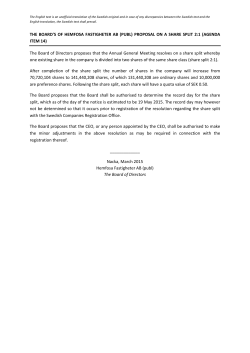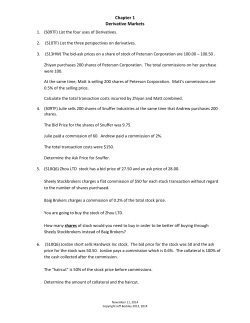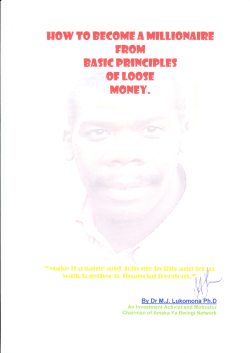
Stockmarket game (AGES 13+) Time
BRING OUR DAUGHTERS TO WORK DAY Stockmarket game (AGES 13+) Time Approx 45 minutes Objective This activity introduces basic concepts in share trading. Children are encouraged to buy, sell or hold shares by interpreting information that affects share prices. Materials and preparation ——PowerPoint slides — daily news and daily prices ——Excel spreadsheet — daily accounts ——Shares ——Monopoly money. Introducting the activity Today we will create a mini stockmarket. In a real stockmarket investors make money by making well-timed decisions to buy, sell or hold shares and holding cash. • What is a share? A share is a unit of value in a company. So, if a company is worth $100 million and there are 50 million shares on offer each share will be worth $2. Owning shares is like owning a ‘piece’ of a company. Shares in public companies are traded in stockmarkets. Australia’s main stockmarket is the Australian Securities Exchange (ASX). • How do you make money in a stockmarket? The main principle here is buying low and selling high. This means buying shares when you think their value will go up, and selling them before their value goes down. You don’t need to buy or sell your entire stock holdings. Depending on your confidence level, you can sell just half, or a quarter of your stocks. www.finsia.com stockmarket game | 1 BRING OUR DAUGHTERS TO WORK DAY Stockmarket game (CONTINUED) • How does this game work? For the purposes of this game, you will trade five stocks, and hold cash. At the start of the game you will hold 100 shares in each company, and $1850 in cash. (NB: details of each of the five companies are outlined in the ‘daily news’ PowerPoint.) In this game, we will run four trading days that last three minutes each. After three minutes, the trading day will finish meaning that the market will be closed and you won’t be able to buy or sell shares. Before the market opens for a new day, there will be news releases. • What are the news releases, and why do they matter? Share prices fluctuate (go up and down) for many reasons, but one of the most important influences on share price is the sentiment of investors. Investor (or market) sentiment is like measuring the general mood about a company. There’s a lot of information that can affect this mood, and you need to decide what information is noise and what information is relevant. Then, based on which pieces of information you believe to be relevant you need to act. This means: ——buying stocks you think will appreciate (go up in value); or ——selling stocks for cash if you think their value will decline (go down); or ——holding onto the stocks you already have. • How will we trade shares? You will trade among yourselves in an open outcry setting — which means you need to run around and find someone who will either sell to you what you want to buy, or buy from you what you want to sell. Be loud, don’t be shy and yell out. • What happens if I can’t find someone who wants to make the trade I want to make? If you cannot find anyone to take the other side of your trade, come to me. I am what you call a ‘back stop’ or a provider of liquidity. But remember that liquidity will cost you $10 for every transaction. This is what we call a ‘liquidity premium’. • What happens at the end of each trading day? At the end of the trading day, we will review how the news affected the value of the shares in your stock portfolio. You’ll learn how successful you were in interpreting the news you received, and your portfolio will rise or fall as a result. www.finsia.com stockmarket game | 2
© Copyright 2025





















